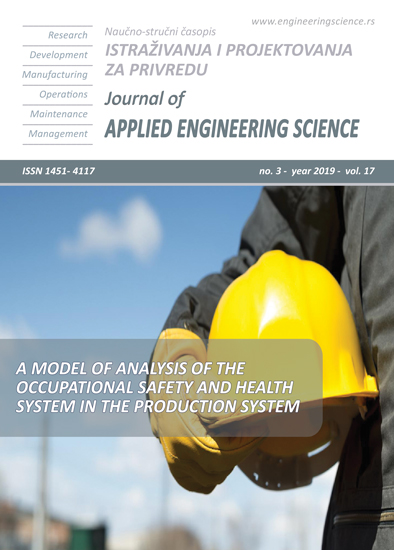A MODEL OF ANALYSIS OF THE OCCUPATIONAL SAFETY AND HEALTH SYSTEM IN THE PRODUCTION SYSTEM
Abstract
The occupational health and safety system as an integral part of the organization of work includes a set of technical and organized measures and activities aimed at achieving safety at work, elimination and prevention of hazards/ harmfulness that can cause occupational injuries, occupational and other diseases and the protection of health and working capacity workers. The main goal of occupational health and safety is to reduce the number of accidents, injuries, occupational diseases and work-related illnesses. An efficient way of managing the occupational health and safety system is achieved by defining, monitoring and adjusting the performance indicators through a systemic and process approach. The modern concept of occupational safety implies that every worker sees himself as an active participant in the occupational safety system who can contribute to the achievement of his goals, but also the responsibility for the process of improving occupational safety for everyone in the organization. A model of analysis presented in this research enables workers to express their views on the elements of the occupational safety and health system in their organization. By applying this model, we can analyze the input elements related to the profile of workers that influence the acceptance and adoption of basic rules and occupational safety measures. The results of the analysis can be an important source of information in the process of knowledge management in the occupational safety system through the creation of measures to eliminate organizational and functional deficiencies.
References
1 Anđelković, B. (2010). The basics of the protection system, University of Niš, Faculty of occupational safety in Niš, Niš
2 Knegtering, B. (2002). Safety lifecycle management in the process industries: the development of a qualitative safety-related information analysis technique, Eindhoven: Technische Universiteit Eindhoven
3 Milazzo, F.M. (2016). On the importance of managerial and organisational variables in the quantitative risk assessment, Journal of Applied Engineering Science, Vol.14, No.1,353, 54-60, DOI:10.5937/jaes14-9842
4 Spasić, D. (2001). Occupational Safety Economics, Graphic company SVEN, Niš
5 Krstić, I. (2010). Models for systemic analysis of technological systems, doctoral dissertation, Faculty of Occupational Safety in Niš, Niš,
6 Živković, S., Pavlović, D. (2014). The comparative analysis of the number of occupational injuries in Serbia, Croatia and Slovenia in 2012, Facta Universitatis, Series: Working and Living Environmental rotection Vol. 11, No 1, 53 - 64
7 Stranks, J. (2011). Health and safety at Work Key Terms, Routledge Taylor & Francis Group, London and New York
8 Petz, B. (1997). Basic statistical methods for non-mathematicians, Edition Waterfall, Zagreb
9 Pallant, J. (2007). SPSS Survival Manual: A Step by Step Guide to Data Analysis Using SPSS for Windows (Version 15), Allen & Unwin
10 Cohen, J.W. (1988). Statistical power analysis for the behavioral sciences (2nd edn.) Hillsdale, NJ: Lawrence Erlbaum Associates, New York

